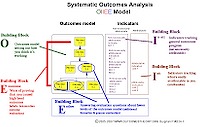Systematic Outcomes Analysis works with the set of basic building blocks which have been identified in outcomes theory - the OIE* Basic Model. These are set out in the diagram on the right.
These elements are:
1. An outcomes model - O. Setting out how you think your program is working - all of the important steps needed to achieve high-level outcomes. Once built according to the set of standards used in Systematic Outcomes Analysis these models can be used for strategic planning, business planning and more.
2. Indicators - I[nn-att]. Not-necessarily attributable indicators showing general outcomes' progress. These do not need to be attributable to (able to be proved that they are caused by) any one particular player.
3. Attributable indicators - I[att]. Indicators which are able to be attributed to particular players (that is, you can prove that they have been caused by one particular player). The measurements of outputs (the goods and services produced by a player) are attributable indicators.
4. High Level Outcome evaluation - E[outcome]. Ways of proving that a particular player caused high level outcomes. Systematic Outcomes Analysis identifies the seven outcome evaluation designs which can do this.
5. Non High Level Outcome evaluation - E[n-outcome]. Other types of evaluation which do not claim to measure high level outcomes, but which are used to improve the outcomes model and examine its context (called formative and process evaluation).
* This was earlier known as the OIIWA model. The model is current being updated so its title may change.
[V1.1.2]

